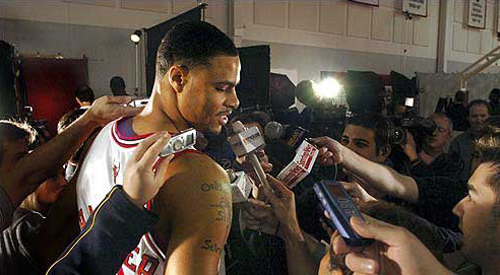
Tyson Chandler’s wayward path to prominence
It wasn’t always this way, but that doesn’t mean this way isn’t better. Maybe Tyson Chandlertells himself this as he sprints down the the American Airlines Center court to beat his man to the block. Then again, maybe he’s moved on.
The faces that surround him these days aren’t the faces he set out with a decade prior, there is no poetically-skilled mammoth in the paint freeing him space to shoot his jumper at the elbow, no championship rings nor comparisons to duos past.
This time around, as a Dallas Maverick, Chandler is a veteran on a team contending for a championship. Sure he assumed he’d be here eventually, but nobody stopped to think that it would be this path that he’d take.
Nabbed with the second overall pick of the 2001 NBA Draft, Chandler was charged with the task of leading the Chicago Bulls back to respectability in a post-Michael Jordan era. His sheer height alone made him an intriguing prospect out of Dominguez High School in Compton, but it was his ability to run the floor and jump that made him stand out as an elite prospect.
With the fourth pick of that very same draft, an overeager Jerry Krause added another 18-year-old with whom Chandler would share front court duties and the pressure of following MJ’s second act in a city spoiled by success.
All they had to do was wait.
Over the next four years, development was slow for both of the rookies, but especially Chandler, a defensive specialist whose impact in limited opportunities didn’t stand out as obviously as that of the more offensively-oriented Eddy Curry.
[php snippet=1]
Though he’d established himself as an intangible force on the defensive end, the fact that Chandler had proved so ineffective on offense made it difficult for him to provide the franchise what they sought after giving up All-Star power forward Elton Brand to get him.
It was inevitable, then, when Chandler was dealt to the New Orleans Hornets in the summer of 2005, the last remnant of the Jerry Krause Era that spanned from 1985 until 2003.
As the years went by in Louisiana, Chandler factored into the success of the Hornets as they rose and fell as contenders in the Western Conference playoff picture. Here it was Chandler – just as much as Chris Paul and David West – who gave post-Katrina New Orleans a young, exciting team worth buying into.
Unfortunately it didn’t last.
Not long after shocking the NBA in 2007-08 with a 56-win, first-place finish in the Southwest Division – Chandler’s best statistical year to date* – the excitement surrounding the franchise waned, the wins subsided and Chandler’s novelty with the franchise wore off.
These days, after serving briefly with the Charlotte Bobcats in 2009-10 and a failed trade that would have landed him in Oklahoma City, the former teenage phenom earns his pay cheques behind the scenes and away from the unforgiving gaze of judgment.
It’s here where Chandler has moved on, pouring salt in the wounds of his opponents with conveniently-timed offensive rebounds, altering shots that only a man of his length could fathom and providing a symbolic inside presence for a franchise that has lacked one for as long as he has been in the league.
No longer expected to carry a young franchise or even help turn an upstart playoff team into a contender, Chandler has embraced his new role while Dirk Nowitzki and the long-established Mavericks take care of the rest. But that’s not to say that he needs them more than they need him.
Though he once stood out, lanky and thin, as a miscast symbol of hope and aspiration, it’s been Chandler’s ability to blend in under the radar with an already high-functioning franchise that has made him the symbol of a championship finally within reach.
Maybe Jerry Krause had the right player all along, he just had the wrong team.
*Here he averaged 11.8 points and 11.8 rebounds per game.
[php snippet=1]

